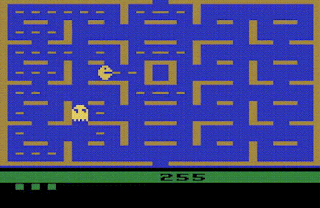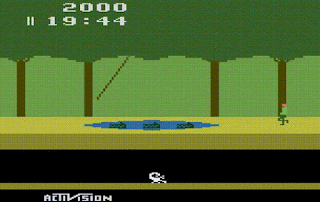The second generation of game consoles dawned once console manufacturers started sticking microprocessors into their products; Fairchild stuck one of their own Fairchild F8s into the design of their Channel F, and Atari stuck an MOS 6507 (a cheaper variant of the 6502 found in many home computers of the era) into their Atari 2600, then known as the Atari Video Computer System. This allowed the new consoles do things that the discrete logic designs of their ancestors couldn’t dream of doing – namely, sprite-based animation, richer sound, and more varied games; after all, you can program software for a CPU but really can’t program software for consoles dependent on hard-wired logic.
The Atari 2600 was the most popular and long-lived console of this generation, responsible for one of the biggest booms and one of the biggest busts in the industry’s history, so I’ll focus on it – the other members of this generation didn’t have quite the same impact, but subsequent members did tend to have superior graphical capabilities so I’ll cover them briefly at some point in the future.
One of the hallmarks of this generation was the debut of sprite-based graphics – we can now have recognizable characters and shapes instead of sticking strictly to squares and rectangles – possibly the biggest leap in video game graphics, and, in my opinion, even bigger than the jump from 2D to 3D. The Atari 2600 was capable of drawing five objects at once – two player sprites, two missiles, and one ball. If this sounds limited, that’s because it is.
As everyone at the time was obsessed with bringing the arcade experience home, the inexpensive Atari hardware couldn’t quite measure up to the often vastly-superior arcade cabinet hardware. The 2600 was equipped with only 128 bytes of RAM in total, shared by the video and the program, and its single MOS 6507 processor couldn't quite measure up to arcade cabinets, with their much more expensive, powerful, and sophisticated hardware. Inflaming this issue was Atari itself, which (without going into too much detail about the company itself) often rushed development deadlines. This often ended up resulting in games that were less polished than they could have been, in gameplay and in graphics.
Even with all that going against it, programmers of the 2600 figured out ways around the system’s limitations. Since the 2600 drew its graphics line-by-line, objects were often reused several times horizontally and in duplicate or triplicate in the same line. This created the illusion of many more objects on the screen than the 2600 itself could actually handle.
Figure 1. Space Invaders for the Atari 2600. This shows one way programmers sidestepped the console's limitations (Spice, 2014, p. 75).
One of the most memorable examples of a game that failed to live up to the hype was the 2600’s original port of Pac-Man. The 2600’s limitations and the rushed development cycle resulted in a game that rendered only one ghost per frame – or, in other words, ghosts that only appeared once every four frames, making them look like they were teleporting all over the place. This extreme flickering was one of the most often-criticized parts of the game, in addition to its radical departure from the aesthetics of the arcade original.
Figure 2. An example of the flickery ghosts from the Atari 2600 port of Pac-Man (RickyC, 2007).
Nevertheless, as the console aged, developers figured out how to make more complicated visuals in the limits of the hardware, and cartridges with more ROM space and added RAM became more commonplace. By being clever with scanlines, sprites, and playfields, programmers learned to make games that look much better than some of the system’s earlier titles. The console was tricked into displaying more onscreen colors and more complex backgrounds, and developers found improved ways around in-game flicker and the console's other limitations.
Figure 3. Pitfall! on the Atari 2600, released by Activision. Activision proved themselves quite capable of making nice-looking games. (World of Longplays, 2017).
Figure 4. Solaris, released in 1986; an example of a very good-looking Atari 2600 game (VWestlife, 2012).
None of this stopped the imminent Video Game Crash of 1983, of course, since the market still ended up being saturated with bad games, with the 2600’s E.T being the most infamous of the bunch. The third generation of consoles would reach the USA in October of 1985, when the two-year-old Famicom made its way over to the States as the Nintendo Entertainment System... but that's a topic for another time.
Nowadays, there’s a bustling Atari 2600 homebrew community; if you have ever felt the urge to program your own Atari 2600 games, you could. Here’s a screenshot from a small project I made in batari Basic, an easy-to-use programming language just for the Atari 2600 created by the community:
Figure 5. Demonstration of batari Basic. (Silverman, Z, 2017).
Other people have made homebrew games that really push the boundaries of the console, sometimes written in batari Basic but more often in the console’s native 6502 assembly language. These games showcase what the 2600 is really capable of with a bit of effort.
Figure 6. The most recent version of Pac-Man 8K by DINTAR816, released in 2015 (mikewayda, 2017).
Figure 7. Halo 2600, released in 2010 and developed by a Microsoft employee (TRexSpaceStation, 2016).
Figure 8. Oystron, released in 1997 (TRexSpaceStation, 2016).
It was unfortunate that Atari acted as it did, choosing to rush games out rather than give them the time they really deserved. Ultimately, they would never be able to quite replicate the initial success of the 2600, try as they might.
References
Davie, A. (2003, 20 August). “Season 21: Sprites” [Message 1]. Message posted to http://atariage.com/forums/topic/32481-session-21-sprites/
References
Davie, A. (2003, 20 August). “Season 21: Sprites” [Message 1]. Message posted to http://atariage.com/forums/topic/32481-session-21-sprites/
Spice, D, Jr. (2014, 7 November). Atari 2600 Homebrew [Apple Keynote slides]. Retrieved from https://www.icloud.com/keynote/000A1y-UrO15wtjsogeOnTJlw#2014_HAE
RickyC. (2007, 23 October). “Atari - Pacman” [Video file]. Retrieved from https://www.youtube.com/watch?v=wtv6SE6RnD8
VWestlife. (2012, 20 April). "Atari 2600 Solaris in STEREO! [Video file]. Retrieved from https://www.youtube.com/watch?v=f68IjW7_w98
mikewayda. (2017, 13 April). "Atari 2600 Pacman 8K" [Video file]. Retrieved from https://www.youtube.com/watch?v=PmHob6BFMe0
TRexSpaceStation. (2016, February 10). "Atari 2600 Homebrew games!" [Video file]. Retrieved from https://www.youtube.com/watch?v=fQY9SIti7YU
World of Longplays. (2017, April 20). "Atari 2600 Longplay [004] Pitfall!" [Video file]. Retrieved from https://www.youtube.com/watch?v=l_lJ-ONcMEs








No comments:
Post a Comment